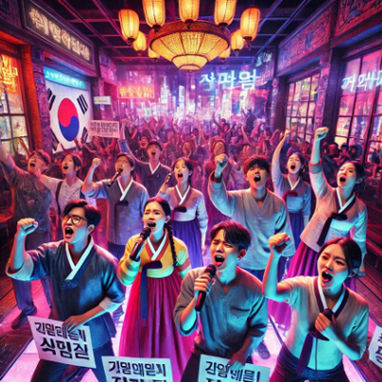
Gangnam Karaoke has become one of the hottest places to be in South Korea. However, the surge in popularity of this karaoke hub is deeply rooted in certain political events that have occurred in the nation.
Over the years, several political events have placed Gangnam Karaoke (강남가라오케) in the limelight, making it culturally relevant. From anti-government protests to elections, these political events contributed to the popularity of this single central hangout spot.
1. South Korean Candlelight Protests From 2016 to 2017.
The cute and peaceful protests, candlelight in particular, that took place in South Korea once again mobilized the society and this time resulted in the sex president’s impeachment.
Raw emotions fueled Gangnam, and the gut feeling that primed people made it feel like singing with people was an act of defiance, a session for togetherness, and a powerful form of protest in and of itself made this venue even more popular.
2. The Presidential Elections of 2012.
When Gangnam Karaoke and many now-popular social media were used for the first time as campaign aids, a surge in youth voting during the 2012 elections rocked the nation.
Many adolescents often met at Gangnam Karaoke to discuss and debate political issues over reasoning and songs.
Karaoke venues became suburban facilities for impromptu discussions, and this pattern of behavior disseminated to more active patrons in the city.
3. The Democratization Movement of the 1980s.
Decades before, Korea was engulfed in a fight for democracy brought about by the dictatorship; pop culture spaces started emerging.
The Gangnam karaoke of the era, while still nascent, turned into a perfect avenue for youth to share their political grievances as well as dreams about a democratic society.
Not only did music become a means of expressing political dissent, but also karaoke bars provided the ideal platform for it.
ALSO READ: How Political Decisions Could Shape the Future of Nang Delivery Services
4. The Korean economy was assessed post-Asian financial crisis in 1997.
As a result of this crisis, Koreans were forced to change their economic outlook, and August 1997 marked a significant turning point for the Korean economy.
At that time, people turned to video songs as a new, fun-filled method of singing through the worries of the past.
As a means of escape from the financial crisis, workers and students flocked to Gangnam Karaoke, which started to rise immensely in popularity.
5. Protest against Mad Cow Disease, 2008.
The development of the Mad Cow Disease protests in 2008 stands among the most powerful actions in South Korea’s history.
After such long, active involvement in the demonstrations held in the streets, many found peace taking karaoke at Gangnam, as it calmed nervous people after intense days packed with political activities.
That’s when karaoke bars were invented, as a way to chill out to music during the time when the political situation was tense.
Conclusion
There have been significant political events in South Korea that have changed the cultural landscape, as highlighted by Gangnam Karaoke.
The 1980s democratization movement and the more recent elections are illustrative of how politics has affected South Korea’s perception of its nightlife.
Gangnam Karaoke is not merely fun; it is an account of a people’s political history as well.

 Storytelling is one of the most powerful tools in shaping political opinions and influencing public discourse. Videos have become the go-to medium for delivering impactful political messages, whether for campaigns, activism, or issue awareness. Wondershare Filmora, known for its simplicity and creative capabilities, has emerged as a valuable resource for those wanting to craft compelling narratives in the political arena.
Storytelling is one of the most powerful tools in shaping political opinions and influencing public discourse. Videos have become the go-to medium for delivering impactful political messages, whether for campaigns, activism, or issue awareness. Wondershare Filmora, known for its simplicity and creative capabilities, has emerged as a valuable resource for those wanting to craft compelling narratives in the political arena.